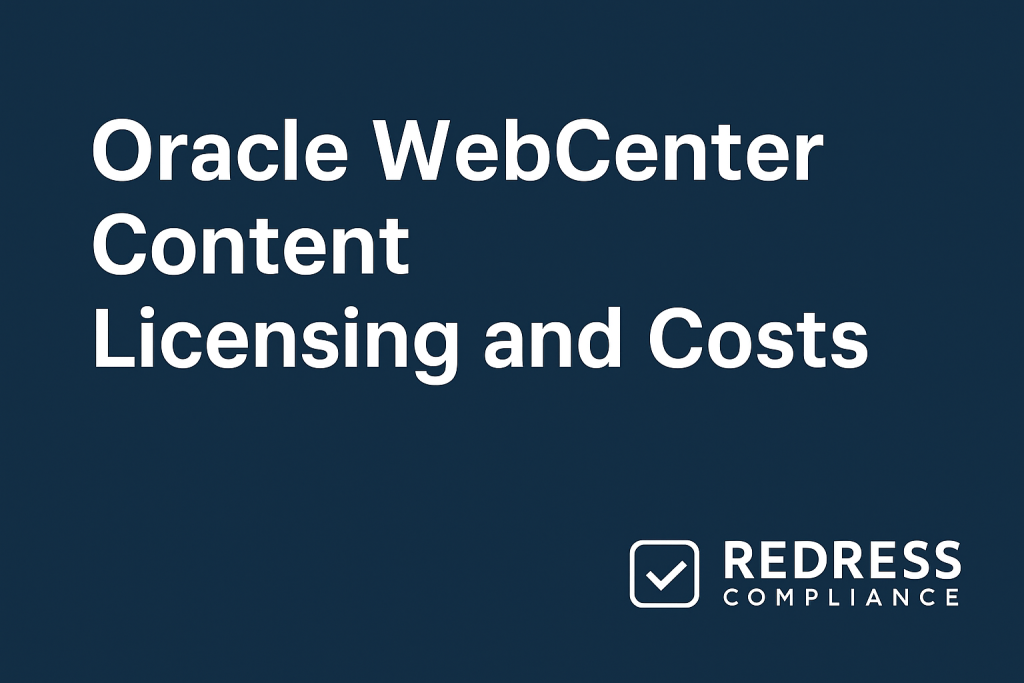
Oracle WebCenter Content Licensing and Costs
Oracle WebCenter Content is an enterprise content management system with complex licensing rules and high costs.
This advisory provides an overview of Oracle WebCenter Content licensing, key cost drivers, pitfalls, and strategies for ITAM teams to optimize licensing and reduce expenses.
Read our complete guide to Oracle Fusion Middleware Licensing.
Licensing Models and Pricing Overview
Named User Plus (NUP): Licenses each user or device accessing WebCenter Content. Oracle requires a minimum of 25 NUP licenses per processor – even a small deployment needs 25 user licenses per server. At list price, each NUP is about $3,450 (plus yearly support fees).
Processor: Licenses the server processors (CPU cores) on which WebCenter Content runs. This model allows unlimited user access once the processors are licensed, ideal for large or external user bases.
A Processor license costs roughly $172,500 per processor (list price). (You must choose either NUP or Processor licensing for a given deployment – mixing both isn’t permitted.)
Note: In addition to license fees, Oracle charges ~22% of the license price per year for support. Over time, support fees can exceed the initial license cost, so budget accordingly.
Oracle also allows Bring Your License (BYOL) to cloud platforms (applying your existing licenses to cloud deployments under Oracle’s policies), or you can use Oracle’s cloud-based WebCenter Content service on a subscription basis instead of traditional on-prem licenses.
Key Cost Drivers and Pitfalls
Managing WebCenter Content can be tricky. Major cost drivers and pitfalls include:
- Over-provisioning: Buying more WebCenter licenses than needed (e.g., a full WebCenter Suite with modules like Portal or Imaging that are never used) leads to shelfware. This wastes budget and incurs needless support fees on unused licenses.
- Under-Licensing: If more users or servers are running WebCenter than you have licenses for (or if an unlicensed test instance is set up), you’re out of compliance. Oracle audits WebCenter frequently, and any shortfall can result in hefty back-license fees and penalties.
- Virtualization Surprises: Running WebCenter in a virtualized environment (such as VMware) can significantly increase costs if not managed properly. Oracle may require licensing all physical hosts in a cluster where WebCenter is installed (unless using an Oracle-approved partitioning method). A small WebCenter instance on a large cluster could trigger a need to license the entire cluster’s cores – a costly surprise if unplanned.
Recommendations
1. Self-Audit Regularly: Periodically review WebCenter Content usage versus your licenses. Catch and fix any compliance gaps before Oracle does.
2. Maintain License Inventory: Keep an updated inventory of all WebCenter Content licenses and where the software is deployed (including test/dev environments). This prevents under- or over-licensing.
3. Educate Stakeholders: Ensure IT teams know the licensing rules (e.g., 25-user minimum per processor, no using bundled WebLogic for other apps). Awareness helps avoid accidental violations.
4. Optimize at Renewal: Before renewing support or buying new licenses, assess your needs. If some licenses are unused, consider dropping or reallocating them to save costs. Utilize renewal negotiations to secure discounts or improved terms from Oracle.
5. Consider Cloud Options: Evaluate Oracle’s cloud offerings for WebCenter. Using existing licenses in the cloud (BYOL) or transitioning to a cloud subscription may offer savings or flexibility, especially if on-premises expansion would be expensive.’
Also read Oracle WebCenter Sites Licensing and Costs.
Checklist: 5 Actions to Take
- Inventory Deployments: List every Oracle WebCenter Content instance (prod, test, etc.) and note the licenses covering each.
- Verify Coverage: Ensure your user counts and processors align with your entitlements (minimum of 25 NUP per processor, with all active cores licensed).
- Identify Gaps/Excess: Flag any unlicensed usage and any licenses you’re paying for but not using.
- Remediate Issues: Reduce usage or buy licenses to close any gaps. For surplus licenses, consider eliminating or repurposing them to reduce maintenance costs.
- Govern Changes: Require a license check for any new WebCenter deployment or user addition. Re-audit usage periodically to stay compliant as your environment evolves.
Read about Oracle WebCenter Licensing Advisory for Enterprise ITAM.
FAQ
Q: Can we run WebCenter Content on VMs or in the cloud without extra licensing?
A: Only if you license it properly. In virtualized environments, you may need to license all physical cores in the cluster (unless using approved hard partitioning to limit it). In the cloud, you can apply existing licenses (BYOL), but must follow Oracle’s cloud licensing rules for counting vCPUs against your licenses.
Q: What’s the difference between WebCenter Content and WebCenter Suite licenses?
A: WebCenter Content licensing covers the core content management platform (with optional modules like Imaging licensed separately). WebCenter Suite Plus is a bundle that includes Content, as well as other products like Portal and Sites, all under one license – at a significantly higher price. Unless you need most of those components together, it’s cheaper to license WebCenter Content (and any needed add-ons) à la carte.
Q: How can we reduce WebCenter Content costs?
A: Align your licenses to actual usage (avoid over-buying), retire or reuse any unused licenses to save on support, and negotiate with Oracle for better pricing or terms. Staying compliant (to avoid audit penalties) also prevents unplanned costs.
Q: Is third-party support a viable way to save money?
A: It can be. Third-party providers can offer support at lower fees than Oracle’s maintenance. This might make sense if you’re not planning to upgrade soon – but you won’t get new Oracle patches, and Oracle may require back-support payments if you return to official support later.
Q: How should we prepare for an Oracle license audit?
A: Keep records of your WebCenter deployments (servers, cores, users) and your license entitlements. Before conducting an audit, perform an internal compliance check and address any identified shortfalls. During the audit, provide the data Oracle asks for – having documentation and an up-to-date license inventory will make the process smoother.
